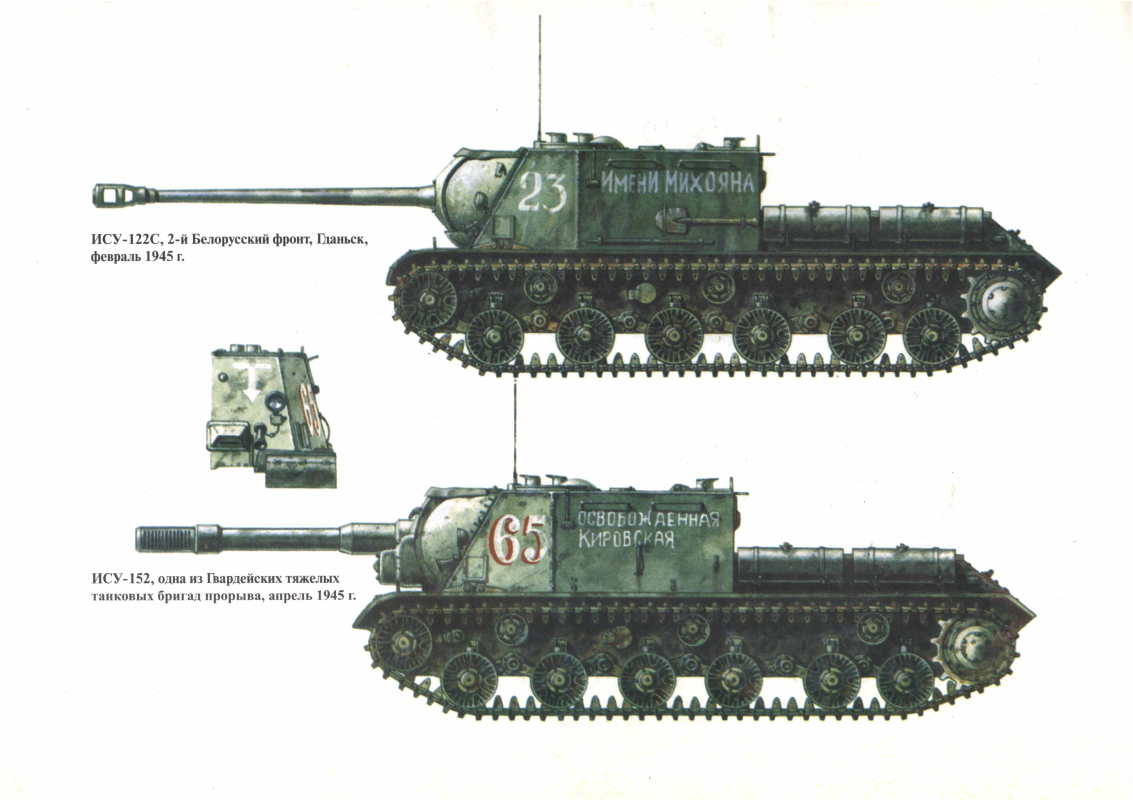
Developed on the basis of the IS tank. The ISU-152 was conceived as a replacement for the SU-152, which was based on the KV-1s chassis. A total of 4,635 vehicles were built from November 1943 through June 1945. The ISU-152 is well-known for its 152mm BL-10 gun. To the average observer the SU-152 and ISU- 152 were visually identical, but the ISU-152 mounted a more modern howitzer known as the ML-20S (with 20 rounds), technically a gun-howitzer and a very powerful weapon, especially at the assault ranges favoured by Red Army tactics. The weapon was protected by an armoured box made up from sloping plates of thick armour, with hand rails around the edge of the roof for use by ‘tank descent’ infantry who used the vehicles to carry them into action.
The success of the SU-152, coupled with the development of the IS (losef Stalin) heavy tank hull, led the NKTP to order design teams at Chelyabinsk, in cooperation the Mechanized Artillery Bureau (BAS) and General F. Petrov, to design two new heavy assault guns based on the IS-2 tank’s hull and chassis. The initial vehicle, designated Object 241, or ISU- 249, was similar to the SU-152, except for a higher superstructure and more rectangular with less sloped side armour.
Thicker frontal and side armour (90mm/3.54in compared to 60mm/2.36in on the SU-152) meant that the internal area of both vehicles was the same, with storage for only 20 rounds each for the 152mm (5.98in) ML-20 howitzer gun. The main difference between the SU-152 and ISU series of vehicles was a lower suspension and a new, heavy two-piece gun mantlet bolted onto the right-hand side of the hull. Re-classified as ISU-152, production began at the end of 1943.
Problems with the availability of the 152mm (5.98in) gun type because of a lack of available manufacturing capacity in Soviet artillery factories led to orders to the TsKB-2 team to explore the possibility of mounting the more abundant 122mm (4.8in) A-19 gun on the ISU hull. This proved a relatively easy task, because both calibres of gun had the same gun carriage, meaning that no radical re-design of the hull or vehicle interior was required. The new assault gun entered service in December 1943 as the ISU-122. In 1944 its firepower was improved with the introduction of the 122mm (4.8in) D-25S gun designed for the IS-2 tank. This modified design, termed ISU-122-2, also had an new gun mantlet and improved crew space. In external appearance both gun types were identical, except for the ISU-152 ‘s shorter gun barrel with a muzzle brake.
The appearance of the immensely powerful Panzerkampjwagen Vlb Royal Tiger in fighting south of Warsaw in August 1944 led to a number of plans to up-gun both types of ISU with the new 122mm (4.8in) BR-7 and 152mm (5.98in) BR-8 long-barrelled guns, but the realization that the Germans could not deploy the Royal Tiger in significant numbers caused production of these prototypes to be abandoned. Another reason was the conclusion of Soviet technicians, based on combat results, that the IS-2 tank could deal with this new threat.
Numerically the ISU-122 was less important than the ISU-152, but the 122-mm version was potentially the more powerful weapon as it fired a higher-velocity projectile than the heavier 152-mm weapon, which relied more upon shell weight for its effects.
Post-war changes were made to the final production run of ISU-152Ks by using the IS-2m chassis and the IS-3 engine deck. A total of 4075 ISU-152s were produced during the war, and a further 2450 manufactured between 1945 and 1955, when production ceased. Despite a brief break in manufacture between 1945 and 1947,3130 ISU-122s were produced up to 1952. The chassis of many of these vehicles were adapted for special purposes in the 1960s. The Oka was armed with a 406mm (15.98in) gun designed to fire tactical nuclear shells to break up NATO front-line and reserve units. The ISU mounted the first FROG medium-range missiles, armed with either conventional, chemical, or nuclear warheads. Outside of these special roles in the Warsaw Pact armed forces, the ISU-152 saw service in its original role with the Egyptian Army in the 1967 and 1973 Arab-Israeli wars.
In Service
The ISU-122 and ISU-152 were used in Independent Heavy Self-Propelled Artillery Regiments, which were awarded the Guards honorific after December 1944. By the end of the war there were 56 such units. Generally attached to the tank corps, they were deployed in the second echelon of an assault, providing long-range direct, and on occasion indirect, fire support to tanks in the first echelon, targeting German strongpoints and armoured vehicles. They were also vital in providing defensive antitank and artillery support for infantry.
During 1944 and 1945 the ISU-152 and ISU-122 were in the vanguard of the Red Army advances through Germany towards Berlin. Some of the first Red Army units entering Berlin were ISU-152 units, which used their howitzers to blast away strongpoints at close ranges and clear the way to the remains of the city centre.
If the ISU weapons had a fault it was that they lacked internal ammunition stowage space. Thus they had to have a virtual constant supply of ammunition brought forward by armoured carriers, which was often a hazardous undertaking. But the massive weapon carried by the ISU vehicles was considered to be of great value in the direct support of Red Army tank and motorized infantry divisions, and both types went on to be used for some years after the war.
ISU-122 [ISU = Iosef Stalin Ustanovka or Gun of Iosef Stalin]